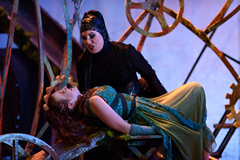| Opera Reviews | 30 April 2024 |
An ebullient production of La Calisto
|
|
Cavalli: La Calisto |
|
|
The 17th century work entwines Greek myths of love/lust between god and human – Giove’s seduction of the nymph Calisto, an acolyte of the goddess Diana, and Diana’s own love for Endimione, a star-gazing mortal. Add that Giunone’s had it up to HERE with Giove’s philandering, Pane having the hots for Diana himself, and fellow-nymph Linfea, on learning that Calisto is no longer a virgin, deciding that she wants a man too. George Humphreys is splendid as Giove, first appearing in elegant black with gold frogging. On the advice of Mercurio – Nick Pritchard in lurid purple lamé Jodhpurs – he dons a wig, high-heeled suede boots and inflatable bosom to disguise himself as Diana, and takes to singing falsetto, to seduce Calisto. As the object of his lust, Paula Sides is infatuated with Diana and cannot believe her luck when s/he actually returns her love. Her singing is glorious. Meanwhile, it turns out that Linfea (an aged nymph) is being sung by a cross-dressing man, tenor Adrian Dwyer in fine voice. The half-goat/boy Satirino is interested, but Linfea is playing hard to get – so far, so pantomime. Katie Bray not only sings well but displays considerable goat-like athleticism, pawing the ground and bouncing around – Jo Meredith keeps the cast in lively movement throughout. John-Colyn Gyeantey is an impetuous Pane in gold brocade, ably supported by Silvano (Peter Braithwaite) in his attempts to get rid of Endimione and have his way with Diana. Tai Oney is a white-haired, check-besuited Endimione, scribbling his calculations on a blackboard, his enthusiasm for the Moon and its goddess endearing him to her, Catherine Carby with some gorgeous high notes. Susanna Fairbairn also has some high notes in venting Giunone’s ire. leaving future relations between Giove and his wife pleasingly in doubt. The programme notes do argue for a serious undertone – concerning the development of astronomy – to the opera. The denouement – Calisto translated to a constellation in heaven; Endimione and Diana, having donned spectacles to ‘see’ each other better, exchanging a single, chaste kiss, - is given symbolic weight with Galileo’s statement ‘eppur si muove (and still it moves)’ unveiled on the blackboard. While it may sound cluttered, Takis’ set of interlinking poles with cogs and wheels bearing constellations, bogeys, step-ladders and a slide by which many characters arrive on stage, works in its quirkiness. As does Mark Howland’s lighting – at one point turning all flat surfaces a rich, mossy green. ETO eschews translating the libretto, the side-titles giving only an outline of the main action. The cast’s enunciation, however, is good enough for the audience to follow the English words. Director Timothy Nelson also conducts the Old Street Band, which provides some very nice continuo playing indeed.
|
|
| Text ©
Catriona Graham Photo © Richard Hubert Smith |

 Too much exposure to big romantic operas can foster the belief that opera is serious, deep and, usually, ultimately tragic. None of these adjectives can be applied, unqualified, to Cavalli’s La Calisto, currently being toured by English Touring Opera in an ebullient production.
Too much exposure to big romantic operas can foster the belief that opera is serious, deep and, usually, ultimately tragic. None of these adjectives can be applied, unqualified, to Cavalli’s La Calisto, currently being toured by English Touring Opera in an ebullient production.






